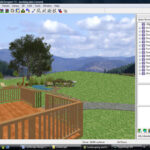If you’ve ever watched a fountain bubbling over, the graceful flow of a pebble-filled stream, or a garden pond’s still reflection, then you know just how hypnotically soothing it is to be near the sight and sound of water.
Those who tend to the metaphysical side of things say our souls are drawn to the wet stuff. Water is life, the ancients say, and its presence in our homes and gardens can quench a spiritual thirst.
Then again, maybe homeowners just like the fact that water features are beautiful and easy to care for. And perhaps the murmur of that koi pond or waterfall in the back yard is all they need to drown out the stress of daily living.
Whatever the reason, water features have become a growth industry. No one knows this better than designer Chris Schriner, whose Mountain View, Calif., company builds around 130 ponds and waterfalls each year in the San Francisco Bay Area.
Schriner’s business includes a retail store, the Pond Shack, and an installation/design arm, Brookside Garden. That way, he covers both types of homeowners: the do-it-yourselfers can find advice, supplies and classes at the Pond Shack, while those who want to leave the digging to someone else can call on Brookside Garden.
“I had one client, a lawyer, and I installed an 11×16 pond with a waterfall at his home,” said Schriner. “He told me that he’d spent $100,000 on landscaping and never went in the back yard. But after we put in the pond, he was out there all the time.”
Heather Donaldson, a Saratoga, Calif., artist who creates one-of-a-kind fountains and water sculptures, said the idea of the garden as sanctuary has become increasingly appealing.
“I think Americans are traveling less, and turning to their gardens as an escape,” she said. “Water is a visually powerful and rewarding element in the landscape.”
The Asian influence in the Bay Area has also left its mark on home and garden design. Hobbyists who raise koi, the colorful carp that originated in Japan, must have adequate ponds for their fish. And Westerners are discovering feng shui, the Chinese system for life enhancement through design, which calls for moving water as a vital element.
Gregg Steed, owner of Cherry Hill Koi and Water Gardens in San Jose, Calif., notes that technology also stepped up to the plate at the right time.
“The introduction of the pond liner was revolutionary,” said Steed. “Before, ponds were made of concrete, which didn’t work very well. They always cracked.”
Another important innovation was the development of new filters that keep ponds and water features clean and free from debris. And organic, too – when the filtration system works correctly, there’s no need to add chemicals to the pond water.
The explosion in water features’ popularity has also given rise to a sea of options. Self-circulating systems, such as in fountains and pondless waterfalls, make it possible to re-use the same water time and again, with just a small amount lost to evaporation. Designers have come up with everything from water percolating in garden urns to elaborate water gardens filled with lotus, lily pads, and Louisiana iris.
Donaldson’s sculptures, made of granite, slate, copper and ceramics, show water’s many faces in the garden. Whether flowing down a wall, burbling up through a glazed cube, or dripping into a mini-aqueduct, water can reveal its unpredictability and playfulness.
Donaldson, who designs between 20 and 40 water sculptures each year, said she creates each piece to fit the client’s needs and to match the existing architecture and materials of the home.
Because there is so much variety in water features, the first step is for homeowners to figure out just what they want. Something small and portable? Go for an urn or a little fountain. Figure you’ll be there a long time? Something more elaborate and permanent can be built.
Those who want to keep koi or water plants have further requirements. Steed said that people who get hooked on koi usually end up building ever-larger ponds as their hobby takes hold.
“My advice is to think about what you want, and then make it twice as big,” he said.
Koi need a minimum 3 to 5 feet of depth, and Schriner recommends building a “fish cave” where they can hide from predators as need be – water birds, like herons and egrets, view koi ponds as convenient sushi bars. Water-loving raccoons can also wreak havoc. (If growing water plants only, a shallower pond will do.)
Whatever the water feature, it is important to have moving water, which is why Schriner recommends installing a waterfall along with the pond. This helps break up scum and discourages mosquitos from breeding.
Other design considerations can keep the pond clean and trouble-free. Using a combination of biological and mechanical filters, the typical pond may only need cleaning once a year. Shriner also designs a “wetlands” pond where plants and rocks enhance natural filtration; this water feature requires cleaning every five to 10 years.
What you spend depends on your sweat equity and the scope of the project. Mass-produced fountains and waterfalls are readily available at the big retailers for a few hundred dollars. A pond can be built by a handy do-it-yourselfer for under $1,000.
Custom work costs more, although not as much as you’d think. Donaldson’s artistic fountains range between $1,200 and $5,000. Schriner’s most popular water feature – the 11×16 pond and waterfall, with rocks, plants and filters – can be installed in two days for around $9,000.
But what water features can add to the home is priceless: an oasis of serenity in a crazy, mixed-up world.
“(A water feature) is soothing and relaxing,” said Schriner. It brings family and friends together. Everyone wants to go out there and feed the fish.”



